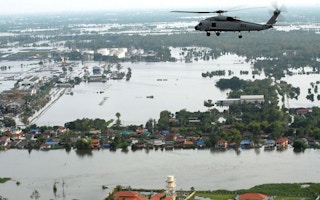An elaborate plan on how Thailand will manage flood waters to prevent a repeat of last year’s disaster will be the centrepiece of Prime Minister Yingluck Shinawatra’s four-day visit to Japan starting tomorrow.
Companies like Toyota were hard hit when rising flood waters forced dozens of factories to close, disrupting production.
Restoring investor confidence to ensure continued investment from Japanese industry is critical to Thailand.
However, implementing the flood prevention plan poses both an economically and a politically loaded challenge for Ms Yingluck’s Puea Thai party.
An insider who had a major role in preparing the plan described it as sound, but said serious questions remained over whether it would be properly implemented.
The plan requires a coordinated and integrated approach by multiple provinces and close to 20 government departments, he explained. On paper, there will be centralised command, but this does not work in practice, he said.
‘There is a lot of water politics in Thailand,’ said the source, who asked not to be named.
‘Water is a precious resource, that is why management and movement of water are highly political and contentious. The flood management plan is being sabotaged from inside the system,’ he said.
‘It is difficult to pinpoint exactly who has the power to do what. And there is a danger of it turning into a series of pork-barrel projects.’
Thailand’s three trillion baht (S$123 billion) flood management plan, which is expected to take 21/2 years to complete, has a number of elements.
It calls for a flood forecasting and warning system and for millions of trees to be planted in water catchment forests in the north to slow down water run-off from denuded hill slopes.
Canals need to be dredged and widened, and new dykes, especially along the Chao Phraya river, and new reservoirs need to be built.
About halfway down the central plains, at a point just above Nakhon Sawan province, the bulk of the water run-off from the north will be diverted to the east and west so that it flows around the city of Bangkok and the industrial estates clustered around it.
The estates themselves will be protected by new, higher dykes. But engineers say the key to water management is not to turn industrial estates into islands, but to allow water to flow smoothly and not accumulate like it did last year.
With the rainy season just three to four months away, the government is rushing to implement short-term projects, which include dredging and widening canals, and repairs to sluice gates and water pumping stations.
Some 4,000 military personnel are being sourced out to the Bangkok Metropolitan Administration to help dredge canals across the capital before May.
Ms Yingluck toured provinces in the north and in the central plains last month to inspect water management systems and refine plans. The five-day trip was declared a success but obstacles remain.
Government insiders point to conflict of duties between government departments.
The irrigation department’s mandate, for instance, is to plan for droughts and use water for irrigation. This means that it often does not agree with the priorities of other departments and local administrations.
The Agriculture Ministry is controlled by a party led by former premier Banharn Silpa-archa. The old-style veteran politician from Suphanburi province, north-west of Bangkok, is in an alliance with the Puea Thai.
‘Banharn doesn’t want flooding in Suphanburi, which produces three crops a year. If there is flooding they may lose one crop,’ a source told The Straits Times.
‘He is the real minister for agriculture. He may not be in the government, but he operates as if he owns the ministry. But (the Puea Thai) needs him to support its push to amend the Constitution.’
Among other challenges is the need to secure public approval through consultation - a complex process - for projects requiring flooding of land, reforestation or shifting of canal-bank communities.
A senior adviser to the Prime Minister, asking not to be named, said: ‘In the short term, we are quite confident of implementation.’
But he acknowledged that there will be problems in the long term, and bureaucratic issues will have to be resolved.
The Council of State - the government’s high-level consultative body on legal matters - is currently working out how to consolidate all legislation on water management, create a single coordinating body or new agency, and also set out the bureaucratic reforms needed to make it work, he said.
Success in managing floods may be crucial to the survival of the government.
There is almost no room for failure as it would severely dent business confidence in Thailand and also erode Ms Yingluck’s credibility.










